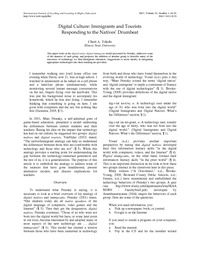 Diese Seite wurde seit 3 Jahren inhaltlich nicht mehr aktualisiert.
Unter Umständen ist sie nicht mehr aktuell.
Diese Seite wurde seit 3 Jahren inhaltlich nicht mehr aktualisiert.
Unter Umständen ist sie nicht mehr aktuell.
 Zusammenfassungen
Zusammenfassungen
 Nach einer Literaturübersicht zum Thema digital natives vs. digital immigrants werden Auswirkungen auf die Bildung betrachtet und eine zusätzliche Rolle des digital tourists eingeführt. Diese Metapher vermag mich aber nicht zu überzeugen, denn mir fehlt sowohl die bei normalen Touristen vorhandene Freiwilligkeit und das beim Reisen in neue Länder empfundene Vergnügen bei digital tourists.
Nach einer Literaturübersicht zum Thema digital natives vs. digital immigrants werden Auswirkungen auf die Bildung betrachtet und eine zusätzliche Rolle des digital tourists eingeführt. Diese Metapher vermag mich aber nicht zu überzeugen, denn mir fehlt sowohl die bei normalen Touristen vorhandene Freiwilligkeit und das beim Reisen in neue Länder empfundene Vergnügen bei digital tourists.
In 2001 Marc Prensky presented a model addressing the differences between current students and their teachers. The purpose of this article is to address some advanced reflections on the models and discuss cultural implications for the role of students and teachers. It is a conceptual paper, which is based on a substantial literature review.
Starting from an outline of Prensky's analogy of digital natives and digital immigrants the author addresses some of the nuances of each group, e. g. different approaches to describe the behavioural patterns of digital natives. Toledo accentuates that young people who grew up with digital technologies tend to have a different way of process information compared to previous generations. This difference produces a gap between the teaching styles of the instructors and the learning styles of their students. Toledo uses an interesting analogue for this cultural gap: digital natives use digital as their first language while digital immigrants use digital as second language.
As technology is becoming an ubiquitous constituent of daily live, this gap has strong cultural implications: While traditionally educators assist students in the assimilation process to become viable members of the society, now with the increasing role of digital technology the majority of students are more familiar with the new social norms than most of their teachers.
How do teachers react to this change? Many teachers behave as digital immigrants, as they are motivated to become more digital native-like, but keep their immigrant's "accent". For example they deal with digital information as they did with print information (e. g. edit documents on a hard copy rather than on the screen).
However not all teachers have the ambition to explore and experiment with technology. Therefore Toledo proposes to introduce the category of "digital tourists", who resist the application of technology to their personal and professional live. Helping the tourist teacher see the positive impact that technology can have on students' learning is the biggest challenge. She suggests a list of ideas of how to help the tourist teacher to move from the print world to the digital world
The strength of this interesting article is that it takes up the very popular and maybe overused analogy of digital natives and digital immigrants, scrutinizes the underlying assumptions and comes up with sound reflections on cultural implications. The extension of the model by a third category (the digital tourist) is interesting, but misses out at the end of the article. Also the implications of teachers could have been elaborated deeper.
Quelle: www.elearning-reviews.org Dieser Text erwähnt ...
Dieser Text erwähnt ...
 Personen KB IB clear | Larry Cuban , Paul Hitlin , Amanda Lenhart , Mary Madden , Marc Prensky | ||||||||||||||||||||||||||||||||||||
 Begriffe KB IB clear | Digital ImmigrantsDigital Immigrants
, Digital NativesDigital Natives
,  instant gratification instant gratification
| ||||||||||||||||||||||||||||||||||||
 Bücher |
| ||||||||||||||||||||||||||||||||||||
 Texte |
|
 Tagcloud
Tagcloud
 Zitationsgraph
Zitationsgraph
 Zitationsgraph (Beta-Test mit vis.js)
Zitationsgraph (Beta-Test mit vis.js)
 Volltext dieses Dokuments
Volltext dieses Dokuments
 |  Digital Culture: Artikel als Volltext ( Digital Culture: Artikel als Volltext ( : :  , 94 kByte; , 94 kByte;  : :  2021-03-21) 2021-03-21) |
 Anderswo suchen
Anderswo suchen 
 Beat und dieser Text
Beat und dieser Text
Beat hat Dieser Text während seiner Zeit am Institut für Medien und Schule (IMS) ins Biblionetz aufgenommen. Beat besitzt kein physisches, aber ein digitales Exemplar. Eine digitale Version ist auf dem Internet verfügbar (s.o.). Aufgrund der wenigen Einträge im Biblionetz scheint er es nicht wirklich gelesen zu haben. Es gibt bisher auch nur wenige Objekte im Biblionetz, die dieses Werk zitieren.










 (
(


 Biblionetz-History
Biblionetz-History